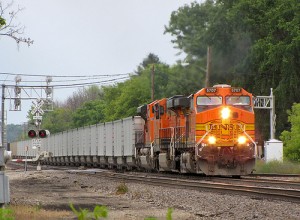
A freight train used to transport coal passes though Durand, Mich. More than half of coal used for electricity is moved by rail. Photo: amtrak_russ.
By Vince Bond Jr.
Jan. 12, 2010
LANSING, Mich. – The next time you’re stuck watching a seemingly endless train at a railroad crossing, look at it as a down payment on your next electricity bill.
Whether freight trains are delivering coal to power plants in mid-Michigan or transporting iron ore in the Upper Peninsula, they still have what it takes to pull the economy forward, said Robert Chaprnka, president of the Michigan Railroads Association.
Almost half of the nation’s electricity comes from coal and 70 percent of that is transported by rail, the association reports.
Whatever trains lack in speed is made up for in energy efficiency, Chaprnka said.
Freight trains can carry 1 ton of cargo 423 miles on 1 gallon of diesel fuel – the distance between Detroit and Syracuse, N.Y.
“First of all, they specialize in hauling heavy loads long distances. We could ship three times the amount of freight on the same amount of fuel than a truck can,” Chaprnka said. “We’re leaving less of a carbon fo otprint. It’s environmentally sensitive.”
Mark Dobronski, president of the Adrian & Blissfield Rail Road Co., said the railroad industry has continued to grow since 1980, when the federal government loosened regulations by passing the Staggers Act.
The legislation gave railroad companies the freedom to set their own prices, choose what services to offer and select their desired routes.
Adrian & Blissfield is a nearly 20-mile long short line system that transports hazardous materials, automotive parts, grain, fertilizer, garbage and scraps through Lenawee County. It also operates a dinner train.
“Railroads are essential. Anything in large quantity is cheaper by rail,” Dobronski said. “It’s in growth mode right now.”
The auto industry depends on the railroads to get their vehicles to showrooms, Chaprnka said.
In 2007, state railroad companies led all national rail systems in moving transportation materials such as cars and auto parts, accounting for 17.7 percent, according to the Association of American Railroads.
“Nearly 70 percent of cars make it the majority of the way by rail to showrooms,” Chaprnka said. “The business is crucial. Parts also come in by rail from all over the country,”
Meanwhile, 20 percent of metallic ore freight loads – almost 13 million tons – originated in Michigan, second only to Minnesota which led the country with 56.8 percent.
The number of small, privately-owned railroads has risen in the last 15 years, said Mike Bagwell, president of the Owosso-based Great Lakes Central Railroad (GLC).
GLC manages nearly 400 miles of track, stretching from Ann Arbor through Clare and Cadillac to as far north as Petoskey and Traverse City.
The company carries such products as barley, soybeans, corn and grain, plus plastic pellets used to make water bottles.
Although there are still “far fewer” companies than in the past, the industry has survived because of affordable freight rates, increased track mileage and overall efficiency, Bagwell said.
According to the Association of American Railroads, there were 24 rail companies in the state in 2007 that employed 3,617 and oversaw 3,699 miles of tracks.
“Things are much more efficient when you do them with one company,” Bagwell said. “Shipments handle more efficiently because it doesn’t cost as much. It’s cheaper to ship now than it was 20 years ago.”
While trucks are better at transporting time-sensitive cargo like produce, trains are more reasonable when delivery windows aren’t as strict, Bagwell said.
“Most shippers look at the economics of it,” Bagwell said. “If you don’t have to hit a time window, then freight is more economical.”
Vince Bond reports for Capital News Service
© 2009, Capital News Service, Michigan State University School of Journalism. Not to be reproduced without permission.
This statistic is used on radio ads by rail companies and I don’t doubt the veracity of it. That’s why most long-haul tractor-trailer trucks run on diesel fuel. Of course, you don’t want to shut a diesel engine off, particularly in cold weather, so I’m not sure idle time is factored in. Also not factored in is the carbon footprint of 50 or more autos queued up at a crossing while a 100-car coal train slowly rumbles by.
Trains are far more efficient than truck, even with old locomotives. But, trains are only the second most energy efficient mode of transport. Water borne transport of cargo uses even less fuel per ton mile. The Great Lakes combination of ships, barges and trains makes it a Great Green area.
I would like to see a follow up article on the actual emissions per ton of freight. Many locomotive engines are very inefficient I have high emission rates of particate matter and other pollutants. Whereas, new diesel truck motors are far more efficient. So, the truth is probably somewhere in the middle. Where freight train have the potential of being far better for the environment, the use of old technology may be holding them back.
“…1 ton of cargo 423 miles on 1 gallon of diesel fuel…”
I’ve heard that statistic often, but never with any citation or explanation of how trains hit that efficiency number.